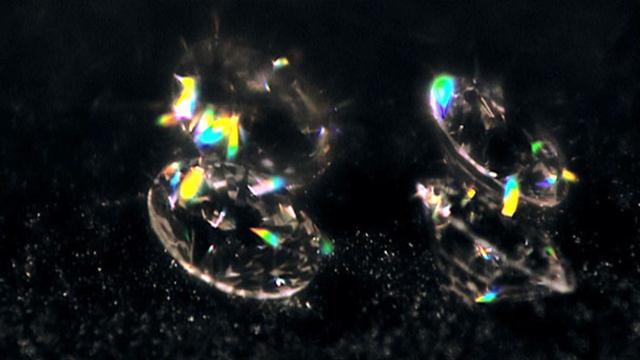The find can tell scientists how ocean crust is recycled throughout Earth’s interior.
Hidden inside a diamond forged deep within the belly of the Earth, scientists have found the first evidence of a mineral that’s never been seen before.
It’s called calcium silicate perovskite, and without a hard casing like diamond, scientists have never been able to keep it stable at Earth’s surface.
“We actually had no idea we would find it,” said Graham Pearson, a professor at the University of Alberta and co-author on a new Nature paper that details the find.
“Most scientists would say you would never find it at the Earth’s surface,” he adds. That’s because when the mineral ascends to the surface, less pressure is exerted on it and its carbon bonds are rearranged. Scientists estimate the mineral is the fourth most abundant mineral on Earth, but they have never been able to observe the substance at the surface.
Other versions of calcium silicate perovskite have been found in what Pearson called “medium pressure form” in other diamonds, but the new find is the first time it has been seen as it exists hundreds of miles below the Earth’s surface.
Unlike the newly seen mineral, diamonds have carbon bonds that are more difficult to separate and rearrange. It makes the material a perfect conduit for studying material embedded deep within the Earth’s surface.
Plumbing the Source
Pearson, along with scientists from universities in Canada, the U.K., and South Africa, have been studying diamonds from South Africa’s famous Cullinan Mine. Before the mineral find, the mine was best known as the source of enormous diamonds that are now among the British Crown Jewels.
“We have a program looking at super deep diamonds with the purpose of obtaining information,” says Pearson.
The diamond containing calcium silicate perovskite was found less than a mile beneath the surface, but Pearson says it would have originated at a depth of more than 400 miles. At that depth, it can withstand the pressure of 240,000 Earth atmospheres. The types of diamonds usually seen in jewelry typically aren’t found more than 100 miles below the surface.
“We have this image of what we think is down there, but there’s nothing like having a piece of this material in your hand,” says Pearson.
He says scientists can use the finding to understand how carbon cycles from the Earth’s surface to its core and back up again in the form of geological activities like volcanoes.
“This particular silicate and the carbon originally started on the Earth’s surface as ocean crust,” he says. “When that gets subducted down in the Earth’s mantle, it keeps going until it transforms into higher and higher pressure mineral phases.”
What Else do Diamonds Hold?
Calcium silicate perovskite isn’t the first geological find to be hidden in diamonds.
In 2014, Pearson and a group of researchers mining diamonds in Brazil found evidence of a water-rich mineral called ringwoodite. In a study on the mineral, scientists found 1.5 percent of it was water. This suggested that large water reservoirs were between the Earth’s transition zone, below the surface, and the lower mantle.
The research team plans to continue mining diamonds, and Pearson says they’re working on diagnosing the diamond’s age. They’ve got some work ahead, as current estimates place it anywhere from “quite young to a billion years,” says the scientists.
Source: National Geographic

































Leave a Comment
You must be logged in to post a comment.